Pictured Above: Farming with his father, no-tiller Garrett Riekhof, says his first priority on the farm is to address areas that have untapped potential, whether it’s variable-rate seeding and fertilizer application or precision excavation services. Photo courtesy of the Univ. of Missouri
While some farmers are attracted to the blinking lights, bright displays and audible warnings of precision farming monitors and equipment, it’s much different for Garrett Riekhof. He’s more attracted to the bells and whistles of return on investment, economic advantage and bottom-line results.
Riekhof farms 1,350 acres near Higginsville, Mo. In the rolling hills of Lafayette County about an hour east of Kansas City, he puts his Univ. of Missouri agricultural economics degree to the test on the fifth-generation family farm, growing almost all no-till white corn, which can yield as a much as a $1 premium over yellow corn.
Riekhof says his fields can have as many as eight distinct soil types and the rolling topography offers plenty of opportunities to practice soil conservation. It also helps him put precision farming equipment to the test, but not before he first tests it in his mind, looking at the cost vs. benefit of any equipment change.
Adoption Plan
Since returning to the family farm after graduating in 2003, Riekhof has been upgrading his equipment fleet to increasingly rely on precision farming technology.
“When I graduated college, Deere was not a real player in precision agriculture equipment; Ag Leader, Trimble and Raven were the pioneers,” he says. “When we first started, we used Ag Leader equipment, but we are slowly moving to John Deere’s Agricultural Management Solutions (AMS). I think AMS has come a long way in meeting farmers’ needs.”
To date, Riekhof has adopted precision farming tools for every field pass, but doesn’t think the equipment market is quite as advanced, and won’t reward him for his efforts at trade-in time. He uses a real-time kinematic (RTK) signal for sub-inch accuracy.
“I use it to steer the planter, so we don’t use row markers. However, I bought the planter with row markers, which cost about an extra $8,000,” he says. “I think it is extra overhead, but they need to be on the planter for resale value. Maybe someday that won’t matter as more farmers adopt RTK technology.”
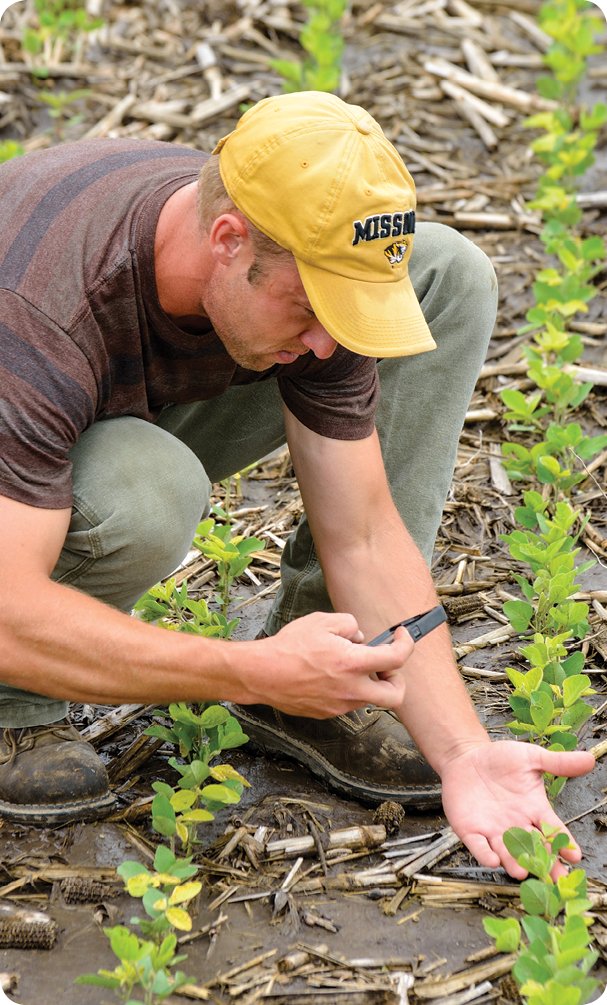
Missouri no-tiller Garrett Riekhof is focused on tracking return on investment from precision farming tools and techniques across the family’s corn and soybean operation.
Any equipment that Riekhof buys, sells or trades will have swath control, and the more sections, the better. But, he’s well aware of the law of diminishing returns.
“For example, with a low-cost input, such as lime, there is less penalty for over-application, so a low-tech applicator is appropriate,” he says. “But you need pinpoint accuracy with more expensive inputs such as fertilizer or seed.”
Accuracy Equals Profit
Riekhof farms on highly variable fields and many are terraced while others lay low and are wet, requiring extensive tiling. He does his own terrace and tiling work, which allows him to easily justify the cost of the RTK subscription from his Deere dealer.
“We use an RTK signal to control the pull-type Toreq 16000 scraper to cut grade,” he says. “Otherwise, we’d need to have at least two people out there, one with a pole working from a laser to make measurements and do the math.
“They can’t always see the grade correctly. When you’re aiming for four-tenths of a foot slope change over 100 feet, it’s very important to be accurate. If you are not, the soil will erode or the water will pond.”
The RTK signal automatically keeps the scraper within spec, and it eliminates workers doing the math on the fly and then relying on a laser and a stick, Riekhof says.
“When you consider $20 an hour labor doing that with a laser and a stick plus the math challenge vs. using the RTK signal that can hold the tight tolerance, that alone pays for the RTK signal,” he says.
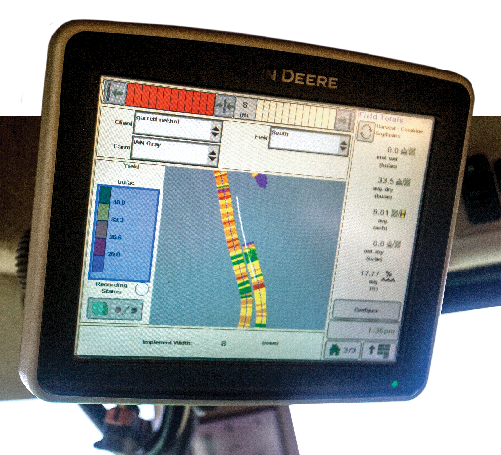
Garrett Riekhof tracks grain unloading from the combine hopper all the way to the bin with a wireless data transfer system. But it all starts with accurate yield data recorded by the yield monitor. Photo courtesy of the Univ. of Missouri.
Riekhof says the RTK signal subscription costs about $1,800 a year. While a Wide Area Augmentation System (WAAS) signal would be free, the RTK signal saves about $300 annually in greater dirt scraper efficiency and it keeps the Riekhof’s sprayer on the same tracks every pass with very minimal overlapping.
Based on those figures, Riekhof estimates he gets a $1,000 profit that he can directly relate to RTK use.
“I can’t put an exact dollar amount of revenue I am generating from it, but the peace of mind and the equipment efficiencies I am gaining are enough for me to justify it,” he says.
Digging for Dollars
Riekhof’s excavation equipment line compares with a well-outfitted excavation contractor. He and his crew run a dozer, dirt scraper, trencher and track hoe for terrace rebuilding and repair and tiling wet areas. The technology lets his team complete these tasks simply and with more accuracy.
Riekhof says it costs $80-$90 per hour to run the dozer and he uses it 150-200 hours a year.
“The custom charge for dozing in our area is about $150 per hour,” he says. “Our goal is to have an ROI on the $120,000 invested in the machine to be about 3-5%.
“Barring any catastrophic repair costs, this saves us about $6,150 annually and ensures we get the work done timely and on our terms. It also gives us the opportunity to create custom hire income.”
Riekhof estimates the track hoe expense to run about 40% less than the dozer, except what it costs to run it. “The custom track hoe rate in our area is about the same as the dozer rates,” he says.
The dirt scraper costs about $30 per hour to run. “We probably use it about 80 hours a year and our area’s custom charge is about $75 per hour,” he says. “Using our 3-5% ROI goal on the $35,000 investment, I figure it saves us about $2,200 annually and we get the work done in a timely way.”
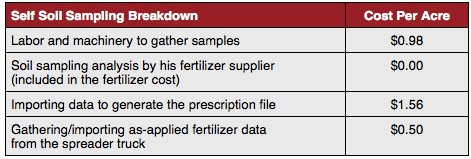
For Garrett Riekhof, doing his own soil sampling vs. his custom applicator pulling samples is more economical and a service he may offer in the future to other farmers to produce more accurate field zones to build variable-rate and prescription maps for fertilizer application and seeding.
It also keeps hours off the more expensive dozer and hoe and, he says, like the other machines, creates custom hire income. Also, because the scraper relies on the RTK signal for navigation, it’s more precise and efficient.
However, Riekhof’s other excavation equipment is manually controlled, but doesn’t need the same level of accuracy to assure proper excavation. He figures the operating cost on the tile trencher at $0.75 per foot.
“We install on average 20,000 feet of tile per year and the custom charge for tile trenching is about $1 per foot,” Riekhof says. “On our $70,000 investment, we’re aiming for 3-5% return on investment.
“This saves us about $2,200 per year over hiring it out. This is our lowest-margin machine and it’s not very efficient. If I were to sell one piece of equipment and custom hire it out, it would be this operation.”
Sprayer: First Choice
If Riekhof didn’t self-perform terracing and tiling work, the first piece of equipment he’d adopt for auto-steering and swath control would be his sprayer. Typically, he makes two applications per crop season, depending on weed pressures and the year.
Herbicides are applied with a Deere 4830 sprayer with a 100 foot boom and seven sections controlled by the GreenStar 2630 display and RTK signal.
“With a 100 foot boom, it’s very difficult to apply herbicides accurately without skips and overlaps,” Riekhof says. “Sprayers run at a high speed too, which makes the problem worse. Auto-steer and a good signal can offer a fast payback on that investment.”
Variable-Rate Fertilizer: Second Choice
After herbicide application, Riekhof would adopt precision equipment that can apply fertilizer at rates best matched to soil type and yield potential.
“I am not totally there yet, and it is the area I am working on now,” he says.
To accomplish this, Riekhof and his two employees pull soil samples from 4.5-8.5 acre grids and work with his fertilizer dealer to get them analyzed. Riekhof then builds his own variable-rate fertilizer maps that his fertilizer dealer uses, with grid size based on field size and variability.
“I hope to get away from grid and intensive soil sampling and move toward relying on soil electro-conductivity maps,” he says. “We use a Veris Technologies 3100 unit to measure soil conductivity and I think this will be an excellent predictor of productivity. It will produce more accurate field zones that I can use to build variable-rate/prescription maps for fertilizer application and seeding.”
Self-sampling vs. his custom applicator pulling samples is more economical and Riekhof also has an interest in doing it. (See table above)
“I would be charged between $10-$15 per acre for grid soil sampling and the prescription fertilizer map generation,” he says. “A good economist adds in the opportunity cost and/or interest on your money. Even if I’m off on my estimates by 50%, I am still making an outstanding return on my invested dollar as compared with a dollar invested in hiring out soil sampling and analysis.”
Although there is money to be saved, Riekhof realizes it’s not for everyone. He admits that most farmers just don’t have the tools, knowledge or desire to do their own soil sampling, analysis and fertilizer prescription development.
“I think that it is such an important part of the crop that I must do it myself,” he says. “Also, the retailer’s job is to sell fertilizer. I am detailed enough and because we do our own soil sampling, I am confident it’s the best rate for that grid area.”
Each field is sampled every other year with probes taken from the exact same sites. This allows Riekhof to chart fertility trends over time. “I enjoy a good puzzle. I look forward to doing this and I’m amazed about what we find out and what stumps us until we figure out what is going on,” he says.
Once the pH and fertility are correct, he says, population, micronutrients and biologicals can be used to push the yield envelope even further. “I think the variable-rate fertilizer application makes my fertilizer dollar work much harder for me,” Riekhof says. “I have seen an increase in corn and soybean yields since we started intensively managing our soil fertility.”
He tries to allocate his fertilizer budget to areas that have the most potential. Without a proper way to measure those levels, Riekhof says he was wasting product and dollars in highly fertile areas and the opposite goes for low areas.
Even with the extensive research, Riekhof hasn’t jumped in with both feet into grid-based variable-rate nitrogen applications. His trials have yet to show compelling evidence to go with it on all fields.
“We are not going totally variable-rate for nitrogen yet. I tailor it field by field,” he says. “Typically, I apply anhydrous nitrogen at 140-180 pounds per acre. On creek bottoms, I’ll increase the rate manually from the tractor cab, but on rocky ridges, I’ll dial it down.”
Combine & Harvest: Third Choice
Riekhof says the RTK signal helps increase efficiency and accuracy while reducing fatigue at harvest. “With all of the dust at dusk, it is difficult to see and operators tend to not use the whole head of the combine to assure they don’t miss any crop,” he says. “It’s a waste of combine and bean head platform capacity. Auto-steer makes the most use of the soybean head and greatly reduces fatigue.”
Riekhof’s 60-year-old dad runs the combine and without auto-steer, he gets frazzled earlier in the day and wants to quit sooner. Auto-steer helps him work at least another hour or so before one of our employees or I take over combining, Riekhof says.
“The combine runs on auto-steer 70% of the time and that greatly reduces stress and fatigue,” he says. “The operator can stretch and look around to assure other components are working right. With auto-steer, I can eat spaghetti with two hands on the go in the cab instead of another ham sandwich because I need to have at least one hand on the controls. It’s about quality of life.”
Riekhof tracks grain unloading from the combine hopper all the way to the bin with a wireless data transfer system.
They use Conservis, which takes yield information from the grain cart scale and transfers it to a tablet app. From there, it gets uploaded to the cloud.
“The scale tickets beat me home and make the information available in a spreadsheet without inputting it by hand,” Riekhof says. “It provides very accurate data on how much is in which bin from which field and its moisture content.
“I can even query it from my cell phone. We use that yield data for crop insurance records, grain sales and documentation for landlords. It is another piece of the puzzle to help quantify our progress.”
Planter: Final Choice
In retrospect, the planter is the last piece Riekhof would add RTK-driven precision capability. Although he has seeding rate and row control on his 16 row Deere 1790 planter, he’s still balancing the cost-benefit of variable-rate seeding in his operation.
“I am trying variable-rate seeding, but I am not ready to go with it in all fields,” he says. “I never win the game consistently enough to change my whole regimen.
“You need the right corn hybrid selected to push population beyond 34,000 seeds per acre and summer weather is the sole predictor of the success of the higher population.”
Riekhof is seeing mostly single-digit yield responses from pushing populations from 31,000 to 34,000 or 36,000.
“If you could tell me the weather we will have during the growing season, I could successfully pick the highest and most profitable population for any given hybrid I grow,” he says. “I’ve also found that sometimes, higher populations do not stand as well at harvest and stalk lodging is a concern.”
Riekhof’s findings about variable-rate seeding soybeans lead him to adjust population based on the soil and temperature conditions at planting rather than basing it on soil grid results. He’s found that conditions later in the summer, not at planting, have the greatest effect on soybean yield.
To assure better seed placement, Riekhof upgraded to Deere’s ProMax 40 seed discs. “This is Deere’s high-performance seed disc and I think it compares favorably with Precision Planting equipment,” he says. “We are seeing more than 96% singulation in no-till, even in rough conditions.
“I don’t think my singulation rate is the limiting factor on yields — after 96% singulation, you are in the area of rapidly diminishing returns.”
Riekhof manually adjusts the pneumatically powered down pressure system to best match field conditions. With some extensively terraced fields in his operation, Riekhof says the 40 foot wide planter is about as wide as he can operate. “On some terraces, it almost reaches from terrace to terrace,” he says. “Until a planter frame that is more flexible is available, this is as wide as we can go.”
Although Riekhof isn’t totally on board with variable-rate seeding, the planter’s precision technology improves his field running time. “With the planter and auto-steer, being able to plant until 2 a.m. vs. 11:30 p.m. makes a big difference,” he says. “If you are going to extend your work hours with RTK guidance on your equipment, also go for high-quality lighting. That also greatly helps reduce fatigue on long days.”

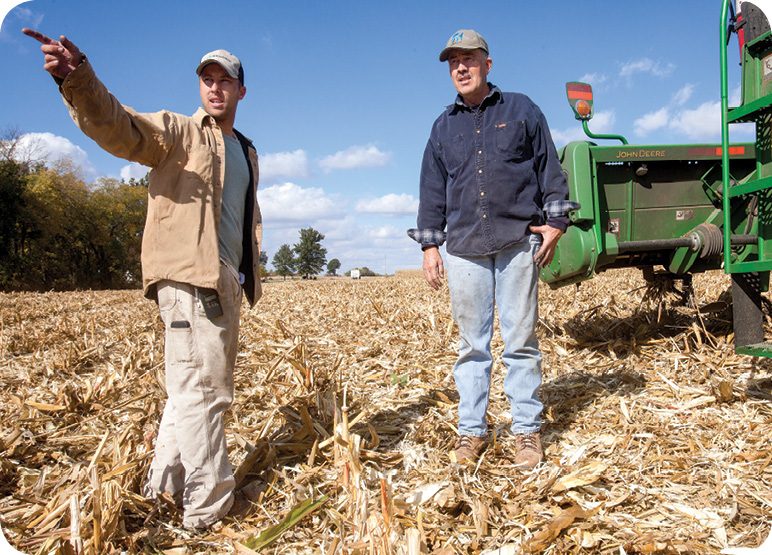
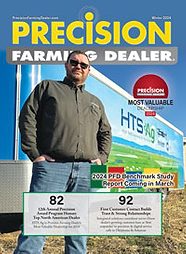
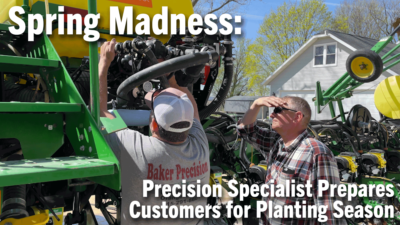



Post a comment
Report Abusive Comment